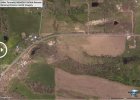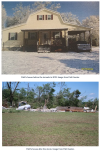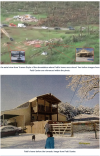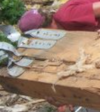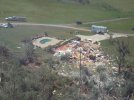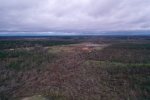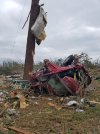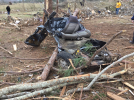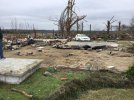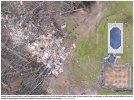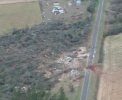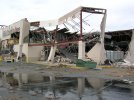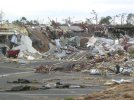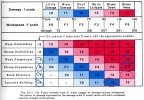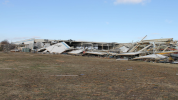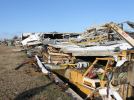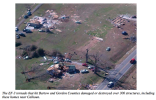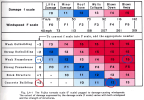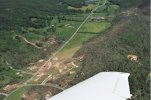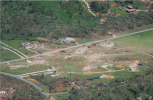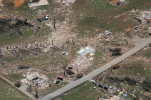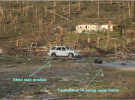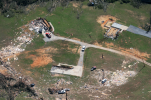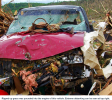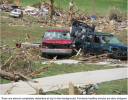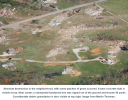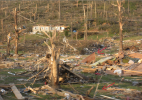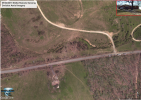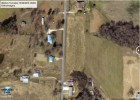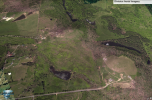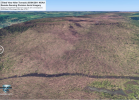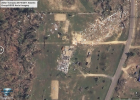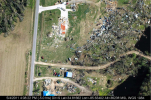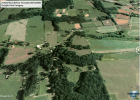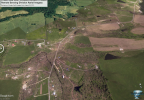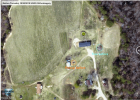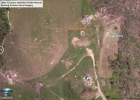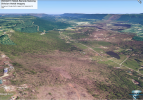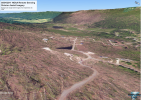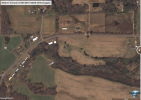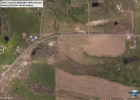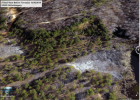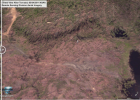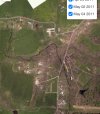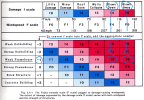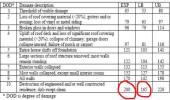Flat Rock, Alabama - Trenton, Georgia EF4 04/27/2011
Path length: 45 miles
Fatalities: 17 (3 were indirect)
Injuries: 125
The tornado began by rapidly intensifying in uninhabited forest and flattened wide swaths of trees. It drug one 30 foot chunk leaving an etch in the ground over 100 yards long. Less than five minutes after formation it was extremely formidable. It annihilated a small brick house leaving barely a trace. The remnants were accelerated to such high speeds that it broke and shattered asphalt on a road 60 yards away.
View attachment 45855
Across the street it hit Camp ToKnowHim and two very large RVs, leaving virtually no identifiable traces. It also tossed a shipping container full of equipment. Violent impact marks were left across the area, along with debarking of trees and severe low-lying shrub damage. Acres of forest were demolished and ground scoured.
Further along the path an F350 truck was rolled 20 yards, and RV was thrown 90 yards, and a single wide trailer was thrown 50 yards before touching the ground. A frame house was also swept clean and a 45 foot tall hardwood tree was ripped out of the ground and dragged 30 yards. Here's the before and after of the property.
View attachment 45856View attachment 45857
A mile later the tornado was even stronger and it bounced a pickup truck 300 yards, and lofted two cars through the air for 100 yards, transported substantial trees significant distances, and obliterated every structure it touched.
View attachment 45858
The tornado continued to strengthen in uninhabited land for 6 and a half miles, destroying a huge swath of forest and spraying dirt across rocky outcroppings and broken trunks. It hit a large downslope with an 800 foot elevation drop and became its most extreme. A vast chunk of old, thick forest was completely mulched. Despite having no structural debris loading there was extreme debarking, and all signs of greenery were almost entirely erased. Many felled trunks were split further into two or three chunks. Years later, aerial imagery revealed there wasn't a single tree that survived in the direct path.
View attachment 45859 View attachment 45860
It finally hit a populated area again and two homes were smeared across the ground from their foundations. One of the NWS surveyors for this tornado, Chris Darden, said all day they had seen "nothing but carnage". He described the second home below as "pretty well built" that was swept away down to the flooring. nearby trees were denuded and debarked. Even most of the carpeting had been stripped. The washer, dryer, and fridge all had disappeared and still weren't located three days later when Chris revisited the site.
View attachment 45861View attachment 45862
With a forward speed of 50 mph, the .85 mile wide tornado crossed from this region into a field where it continued to flatten and debark large swaths of forest. Unfortunately, on the other side of that field were dozens of residences. Many were obliterated along with everything else in the tornado's path.
View attachment 45863View attachment 45864
Some seriously incredible contextual damage occurred here with exclusive pictures that Tornado Talk explicitly forbids from being shared. This includes a concrete porch slab of a double wide that was knocked 10 yards from its original location, A huge hardwood ripped out of the ground (leaving a deep crater) and carried 50 yards, the foundation of a double wide that was ripped out of the ground concrete and all.
I've summarized barely over half the article, and posted maybe 5% of the pictures. It goes seriously in depth showing the nonstop carnage this tornado caused. I now agree with other user's claims that this was close to Smithville in strength. Highly recommend subscribing and checking it out.

www.tornadotalk.com
New rating: (E)F5
Reasons: Dozens of instances of incredible phenomena, strong framed houses obliterated, unbelievable vegetation damage, and countless huge projectiles and vehicles carried over 100 yards.

